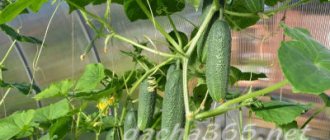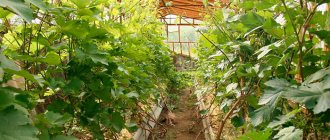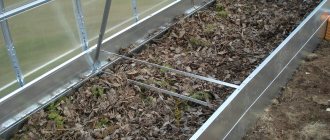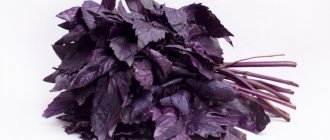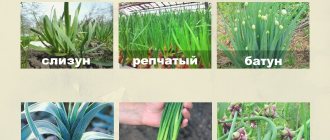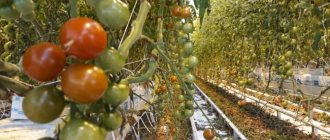It is still possible to get a good grape harvest in regions with harsh climatic conditions.
Grapes are grown in Siberia in a greenhouse. Perhaps this is the only way that will allow you to enjoy healthy and tasty berries grown with your own hands. Greenhouses in regions such as the Urals and Siberia are a common occurrence. With the help of such structures, residents receive healthy and fresh vegetables and fruits from their mini-gardens and orchards. As a rule, two types of greenhouses are installed:
- The first type is greenhouses that have a common wall with a residential building; the advantages of this type are heating savings due to heat transfer from the walls of the heated house. Such a greenhouse requires good ventilation in the summer season. To harvest an earlier harvest, experts advise installing just such a greenhouse.
- The second type is a separate building covered with polycarbonate. Install it on the north-south side for sufficient natural lighting of the crop. The sizes of buildings are selected depending on the desires and capabilities of the gardener. There is only one requirement regarding the height: it should not be less than 2.5 meters.
Grape varieties for Siberia
The opportunity to grow large and sweet grapes in Siberia is a good gift for gardeners in this region. Varieties have been developed that are adapted to a sharply continental climate with strong fluctuations in both daily and annual temperatures. The warm period without frost here lasts three months: from early June to early September. Therefore, early varieties grow well in Siberia: Muromets, Solovyova-58, Tukay, Rusven, Kodryanka and other early ripening varieties, in which 90–115 days pass from bud break to full ripeness of the berries.
Photo gallery: grape varieties suitable for growing in Siberia
Schemes of Siberian viticulture (SVV)
The experience of breeders was generalized, systematized, and two systems for growing crops were developed.
Scheme No. 1
The basis is the grafting of selected early varieties onto specially selected grape rootstocks taken from natural growing conditions. The harvest was produced by plants grown from cuttings of Amur varieties of the crop. Technology Features:
- when planting, trenches are dug;
- the vine is not tied up until the onset of stable heat;
- The load on the shoot is determined only after the end of frost.
In areas beyond the Ural Mountains, it is difficult to predict the return of cold weather in the spring, so you should not take risks and normalize the load in advance. Bushes are formed on vertically installed supports. Be sure to leave spare eyes in case the bushes freeze.
During the growing season, they do not need treatments against diseases and pests. The explanation is simple: there are no outbreaks of dangerous infections in the region, so they are content with only loosening the soil around the bushes. For grafting, only low temperature-resistant rootstocks are used.
Scheme No. 2
The crop is grown from cuttings. Early varieties are planted, preparing their own planting material in the fall. In winter, it is stored in the cellar, buried under shelters along with mature bushes. Peculiarities:
- when cultivating on fertile, chernozem soils, they do without digging holes or applying fertilizers;
- on loam, clay or sandy soils, dig small holes for planting;
- there is no spring pruning (except for the removal of diseased branches).
Planting in small holes, trenches or boxes is common. In depleted soils, holes are dug and fertilizers are applied. In the same way as according to scheme No. 1, no spraying is carried out against diseases. They only remove weeds from the rows and lightly loosen the soil.
Before wintering, cover the vine in trenches, grooves, and under arches. Wintering conditions are determined by cultivation technology, as well as specific climatic conditions. In practice, gardeners use different technologies, combine schemes, choosing options that suit them. Do not exclude fertilizing, processing of plantings, and hardening of the crop to obtain a better result.
Planting grapes in Siberia
Proper planting of grape bushes is one of the important factors influencing a good harvest.
Selecting a location
Choose a place that is sunny and protected from the wind. Grapes should not be planted in lowlands, where frosts, fogs and stagnant water are more common. On a personal plot, it is better to place grapes near a blind fence or wall of a house facing south or southeast.
In one place, grapes can grow and produce good yields for 15–20 years.
Video: choosing a place for grapes
Deadlines
The most favorable time for any planting in Siberia is spring. Autumn here is very short, snow can fall as early as September, and seedlings simply will not have time to take root during autumn planting. Plant grapes in May under cover (in a greenhouse, hotbed) or in open ground, when the threat of frost has passed. In some regions of Siberia there are snowfalls even in early June.
In Siberia, there is a high probability of frosts and snowfalls until June, so seedlings purchased in the spring must be kept on the windowsill until the weather warms up.
Pit preparation
During the growing season, grape shoots grow by 5–10 cm per day. Such active growth requires good nutrition. If grapes are planted in unprepared soil, then all the nutrients from the top fertile layer are quickly consumed. The bushes will develop and bear fruit poorly. Therefore, at least 2-3 weeks before planting the seedlings in a permanent place, planting holes are prepared for them and filled with fertilizers.
Preparation of planting holes:
The grapes are planted below the soil level on the site, the walls of the trench are reinforced with shields
For Siberia, with a planting depth of 20–40 cm, the heat received during the summer is used as fully as possible. The trench can be made wider, then it will be better illuminated by the sun. The planting pit is also often made larger. It is believed that a 1 m deep pit, filled with organic matter and mineral fertilizers, will provide the grape bush with nutrition for 10–15 years, that is, fertilizing will not be needed throughout the entire cultivation.
If you want to do without fertilizing and not dig a huge hole, sow the soil under the bushes and between the rows with green manure: alfalfa, mustard, clover, peas, lupine, wheat, oats. These plants contribute to the redistribution of nutrients between soil layers and the accumulation of humus. Grow green manure until flowering, then cut it and place it under the grapes as mulch.
Drainage system
There are recommendations to lay drainage made of stones and broken bricks at the bottom of the planting hole and install a pipe through which the grapes are watered. But there are also reviews from gardeners who did not see the difference between planting grapes in “smart” pits and in ordinary ones. When watering through a pipe, the roots are drawn towards it, rather than developing evenly in depth and breadth. Over the years, drainage becomes silted and the roots can rot.
The “smart” pit in Siberia does not justify the effort required for its construction
Many winegrowers agree that “smart” pits are needed only in the first 1–2 years after planting, and later they lose effectiveness as the roots extend beyond its boundaries. However, in the climatic conditions of Siberia, it is not advisable to make drainage systems, since young non-fruit-bearing bushes rarely need watering - 2-3 times per season.
There are few hot days in the region; the weather is often rainy. In addition, the evaporation of leaves from young grapes is minimal; they have not yet developed into a strong bush. The best option is to place branches at the bottom of the hole instead of stones, which will rot over time and turn into fertilizer, and after planting, cover the soil with a layer of straw, hay, grass cuttings or green manure.
Seedling preparation and planting
Grape seedlings in Siberia are rooted cuttings with a closed root system. They are sold in plastic cups. Many people buy them in early spring, while there is a choice and prices are low, so preparation for planting and planting itself consists of the following stages:
Video: how to properly plant grapes in Siberia
Preparing the soil for planting
- Grapes should be grown on loose, nutrient-rich, moisture- and breathable soils with a neutral (within 6.5-7.5) acidity level.
- In order for the harvest to be abundant and the berries to be tasty, the soil on the site must be moist and warm, but in no case waterlogged or too heavy (clayey). Groundwater must lie at least one and a half meters below the substrate level.
- Vines grown in areas that are waterlogged or periodically flooded are often affected by fungal mold.
- The area intended for setting up a vineyard is prepared in the fall: the soil is carefully dug up, old roots are selected from it and natural organic fertilizers are added (compost, mullein or green manure), and then its surface is leveled.
- Before planting seedlings, the growing soil is fertilized with a solution of dry mullein (at the rate of 10 kg per square meter). When using compost, you will need at least 10-15 kg per square meter. meter of plot.
- You can fertilize the soil on the site for planting a vineyard by growing green manure plants (Pancake radish or lupine). The roots of these crops, reaching 4-5 meters in length, not only help improve the soil structure, but also create conditions that facilitate the penetration of oxygen to the plant roots.
- In the absence of organic matter, mineral fertilizers can be added to the soil under the vineyard. The most popular among gardeners is the phosphorus-potassium mixture “Agrofoska”. Its consumption when applied to light soil is 10 g per square meter. meter; in heavy – 20 g per 1 sq. meter.
- Any fertilizers (both mineral and organic) applied to the soil of the future vineyard should be embedded into it as deeply as possible.
Caring for grapes in Siberia
Growing grapes is a complex of agricultural practices, which includes: watering, shaping and thinning, tying to trellises, providing heat, shelter for the winter. Diseases and pests of grapes have not yet reached Siberia, so there is no need to spray the plantings with anything.
Watering
This sunny crop is resistant to drought and heat. The soil under the grapes should be dry. The need for water is determined by the appearance of the plants - the leaves lose their elasticity in the heat and droop. To water the seedling, make a groove 15–20 cm deep around the circumference, 30 cm away from the stem, pour 5–15 liters of water into it. The rate depends on how well the soil absorbs. Use only water heated by the sun. After watering, level the ditch and mulch.
To water the grapes, dig furrows or holes
In the Siberian summer, seedlings will rarely need to be watered after planting, especially if the vineyard is located in a place protected from the wind and the ground is covered with mulch. A fruiting vine needs more water. But the frequency and rate of watering depends on the weather. The signal is still the condition of the grapes. Pay special attention to it during the periods:
If the weather is dry during these important phases of development, be sure to water the grapes, wetting the top 30–50 cm. Do not water during flowering! In August, watering is also undesirable; the vine will ripen better without it.
About the importance of mulch
Mulch keeps the soil moist and loose, the bottom layer gradually rots, and the top remains dry and does not allow fungi to develop. Thanks to mulch, there are no sudden temperature changes in the root zone during rain; in hot weather, the covered soil remains comfortably cool. In addition, such litter, when rotting, releases carbon dioxide - one of the elements of photosynthesis.
Apply mulch in the spring only after the ground has warmed up. Rotted sawdust, grass cuttings, hay or straw are suitable. By autumn, these natural materials will rot and enrich the earth with humus.
Mulch keeps the soil moist and loose, the bottom layer gradually rots, and the top remains dry and does not allow fungi to develop
Bush formation
In the first year, start with a garter; it is not necessary to build a trellis, just stick stakes or reinforcement 1.5 m high next to the seedlings. Leave the two strongest shoots on each cutting; when they grow to 50–60 cm, tie each to its own support in the shape of the letter V. It happens that only one shoot grows on a cutting, tie it up too.
All summer long, stepsons will grow from the axils of the leaves; they need to be pinched. Some winegrowers recommend pinching the stepsons not at the base, but above the second leaf. In their opinion, additional leaves improve photosynthesis, and the young vine receives more nutrition and strength. In August, do the chasing, that is, pinch the tops of the main shoots.
Stages of forming a bush from a seedling with two shoots (the simplest scheme):
Photo gallery: pruning grapes by year
If only one shoot grew on your seedling in the first year, then in the fall cut it into two buds, from which by next year you will form an arrow and a replacement shoot, then follow the given scheme. In Siberian conditions, you can leave shoots with a large number of buds (5–6), that is, do not shorten the vine too much in case of freezing in winter. But in the spring, do not trim the main branches, but blind the extra buds and shoots. If you leave them, they will take away strength, thicken the bush, and the grapes may not have time to ripen in a short summer.
It is not recommended to prune grapes in the spring. At this time, sap flow begins, the wounds on the grapes do not heal well, the vine “cries”, loses a lot of strength, will develop poorly, and may die.
Clusters will be formed on vertical shoots already in June; leave only the lower, well-developed ones, and pluck out the upper ones. If you leave everything, then in a short summer they will not have time to ripen.
Having understood the principle of formation, experiment, leaving different numbers of buds, shoots, and inflorescences. This way you will find out from your own experience under what conditions you can get the maximum yield.
How to provide additional heat to grapes in Siberia (arrangement of trellises)
Trellis can be not only a support, but also protection for grapes. Classic trellises consist of metal or wooden posts with wire stretched between them.
Design features of trellises that allow heat accumulation:
Video: single-plane trellis for grapes
Sheltering grapes for the winter
After harvesting (and young seedlings in late August - early September), the grapes need to be protected from the first frosts. To do this, cover the ground under the bushes with old film, remove the vines from the supports, lay them on the film, and build a greenhouse on top in the form of a tunnel made of polycarbonate or arcs and film. As a result, when the temperature drops at night, the leaves will not freeze, and during the “Indian summer”, when there are still warm days, photosynthesis and bud ripening will continue.
After leaf fall, with the onset of cold weather, remove the temporary shelter and leave the film on the ground. Build something like a box with sides on top. It is necessary to make such a structure so that the grapes are in the air gap, and not sandwiched between the upper and lower shelters. Place cardboard, foam sheets, agrofibre, burlap or other insulation on the sides of the box. Cover the whole thing with film on top and tuck the edges in place. Water should not get inside the shelter, otherwise the grapes will dry out. For waterproofing, you can use slate, roofing felt and other materials.
The grapes are placed in boxes, insulated and protected from getting wet by slate
In winter shelter, grapes should not come into contact with metal (arcs, pins). Otherwise, the shoots in this place will freeze and the buds will die.
In the spring, when the snow melts, remove the cover. In Siberia, this can happen in April and May. There is no need to wait for the soil to thaw. Don’t raise the vines, but build a greenhouse, just like in the fall. You can remove it and tie the shoots to the trellises only when the threat of frost has passed, that is, in June. On warm days, do not forget to open the ends and ventilate.
How to deal with diseases and pests
In the Southern Urals, grape diseases are not as common as in warmer regions. However, if agricultural practices are violated, the vines can be affected by oidium, mildew, and gray rot, depending on the variety. To prevent the development of infection, it is recommended to follow a number of rules:
- Carry out preventive treatment with fungicides before the buds swell, during the ovary period, and again after harvesting.
- Purchase healthy seed material from specialized nurseries.
- Apply nitrogen-containing fertilizers in doses, without abuse.
- Remove fallen leaves from under bushes.
- Prevent weeds from growing.
- Do not over-moisten the soil under the grapes.
- Carry out pruning and pinching in a timely manner, you can even pick off the leaves that thicken the crown.
- Maintain distance between plants.
- Inspect the vineyard regularly.
At the first signs of disease, the bushes are sprayed with fungicides and treated with colloidal sulfur. The affected parts are removed and then burned to prevent the infection from spreading.
In winter, mice can gnaw on the vines and make nests in the warm shelter of the grapes. The smell of spruce branches will repel rodents. You can also place rags soaked in kerosene around the covered grapes, the smell of which mice cannot stand and will avoid the area.
Some years ago, grapes in the northern regions were considered exotic. Now, thanks to breeders and enthusiasts, even beginning winegrowers can grow this originally southern berry in their gardens. It is only important to choose the right variety and follow the principles of grape agricultural technology in the conditions of the Urals.
Reviews and advice from Siberian winegrowers
It is very possible even in Siberia, and specifically in Altai; in Biysk there has been a school of winegrowers for a long time, and grapes have become widespread among amateur gardeners, even varieties of our Siberian selection have been bred. I have been working with grapes for a long time, Zhemchug, Sabo, Tukay, Aleshenkin, Muscat Katunsky are successfully bearing fruit, although only very early and early varieties ripen in our country and they require shelter for the winter, but it is worth it to see the results of your work.
Veniaminovich
https://dacha.wcb.ru/lofiversion/index.php?t9607.html
No matter how lazy you are, in Siberian conditions you will still have to tinker with grapes (if the climate does not change). No matter how you accumulate heat, snow often falls in Siberia at the end of May - beginning of June - in this case, if the grapes are not covered, they will freeze, and you may not get a harvest from the stepsons - the summer is very short. There are also frosts in August, and at the end you also need to cover them... The ideal option is a greenhouse, like in the Baltic states.
Buttercup
https://forum.tvoysad.ru/viewtopic.php?f=50&t=1129
Mix_Servo
https://forum.vinograd.info/showthread.php?t=10545
Growing grapes in Siberia is a difficult but interesting activity. The main thing is to prevent the bushes from freezing in winter and provide the maximum amount of heat in summer. If clusters of ripe grapes appear on the vines, it means that all your efforts were not in vain. You can be awarded the honorary title of winegrower, because not every gardener can successfully cultivate this crop, even in the south of the country.
Source
Features of a greenhouse for grapes
A greenhouse designed for growing grapes has significant differences in its design from traditional greenhouses for tomatoes and cucumbers. Let us consider separately all the features that need to be taken into account during construction.
Dimensions. A greenhouse for growing grapes must have a significant height - from 2.5 to 3 or more meters, depending on the design and size of the trellises. The optimal building area designed to meet your own needs for grapes is 25-30 m2. Larger greenhouses can be used to grow berries for sale or wine production.
Greenhouse for growing grapes
Foundation. The soil in a greenhouse for grapes must be reliably protected from freezing. In addition, without a foundation, weeds, pests and uncontrolled drafts will penetrate inside. Build a shallow concrete strip foundation.
Sheathing. For a greenhouse, it is desirable to use transparent cellular polycarbonate - a material with high light transmission and good thermal insulation properties. Polyethylene film is acceptable, but only for unheated structures.
Diagram of an example greenhouse
Prices for cellular polycarbonate
cellular polycarbonate
Frame. Grapes do not like to be rushed and do not begin to produce a good harvest right away, so the greenhouse must be durable and have a significant service life. And as a material for the frame, the optimal choice in such conditions would be galvanized steel profiled pipe - it is quite strong, durable and easy to work with.
Heating. If you plan to grow grape varieties that are not designed for cold weather, then the greenhouse will need heating. To do this, you can use infrared lamps suspended from the ceiling (in this case, you will need to significantly strengthen the frame of the building), or a heating cable placed under the soil of the greenhouse. For those who like simple options, installing conventional heating radiators is suitable.
IR lamps for heating greenhouses
Heating cable installation
Lighting. Southern grape varieties in the conditions of Siberia or the North-West may lack sunlight. This drawback can be corrected with the help of special fluorescent lamps. They are represented by fluorescent, LED and sodium subtypes.
Ventilation. For a small greenhouse designed for growing grapes for personal consumption, two windows located in the gables of the building will be sufficient. If you plan to produce berries or wine for sale, then the greenhouse should be larger, and accordingly, the number of transoms should increase. To ensure an optimal microclimate, equip all vents with thermal cylinders that open and close the doors at a certain air temperature inside.
Photo of a bimetallic element for automatic greenhouse ventilation
Special fan for greenhouse
Important! Unlike other crops, grapes do not require frequent watering. But doing it (watering) manually requires a lot of labor and time. Partially solving this problem will help by installing an automatic watering system controlled through a regular valve or a special microcontroller.
Drip irrigation in a greenhouse
Pros of growing in a greenhouse
Cultivating a crop in protected soil has many advantages. When growing in a greenhouse, you don’t have to worry that the grapes won’t have time to ripen before the cold weather sets in, because the climate in the greenhouse can be controlled independently. In addition, even in the south, many winegrowers prefer to grow berries indoors, because this way they can get the harvest much earlier than expected. This is especially true for those farmers who are engaged in entrepreneurial activities and grow grapes for sale. The advantages of greenhouse cultivation also include:
Where to hide grapes for the winter?
This is a very important nuance: in winter, the cuttings breathe and spend the nutrients stored in them. The warmer it is, the more intensively they spend them, which is quite consistent with the logic of biological laws. There is no other source for them at this time. And many people mistakenly believe that the shorter the cuttings are kept in winter, the weaker they are later, but the earlier they are planted, the better. This is a fairly common myth today, due to which even in greenhouses the required yield is not always achieved. Why, are you wondering?
The thing is that grapes, like other plants, have their own important period of rest - when all processes are suspended. This can be compared to a person's sleep - what is the use of it at this time? But as soon as we reduce these important hours, lethargy, apathy and even illness appear on our face. So there are two types of dormancy for grapes: deep, i.e. natural and forced. In deep dormancy, its seeds do not develop, no matter what you do with them. And then, when the plant is ready for the growing season, a period of forced dormancy begins. And as soon as you provide favorable conditions for the roots - sufficient temperature and humidity - the biological process will move on. But remember that for different grape varieties this period varies in length, on average until January.
That is why many winegrowers consider the month of January to be more or less rational for starting rooting, but more experienced specialists in this field do not recommend starting work so early - daylight hours are still very short, and illumination for rooting cuttings is a very, very important factor. Ideal dates are in the second half of January, and not earlier. Without keeler - only at the end of February. And in any case, try to use artificial lighting and reflective foil screens, otherwise you will completely postpone the rooting date to the beginning of March.
Please also pay attention to this point: if you planted the grapes quite compactly and their roots even extend beyond the greenhouse, be sure to warm them with manure. That's all science! Do you dream of huge juicy bunches of grapes and natural homemade wine? Feel free to get down to business!
Vasha-Teplitsa.ru
Variety selection
Almost all varieties are suitable for greenhouse cultivation, but the best productivity is shown by those that have early ripening periods. For the first time, it is preferable to select cold-resistant, highly immune, shade-tolerant varieties that are guaranteed to produce good offspring. Considering the size and height of the greenhouse, it is recommended to give priority to medium-sized and weakly branched varieties.
Table of varieties most suitable for greenhouses:
Soil features in the Urals
The peculiarity of the Ural soil was noted by many summer residents. It is thanks to the soil and cold weather that grapes grown in the Urals have strong immunity to viruses and diseases. Hybrids of Amur varieties are especially different at this point.
Russian scientists have developed these persistent, non-covering varieties and can rightfully call them environmentally friendly, since they do not require chemical treatment during the growth process.
Greenhouse requirements
In a properly equipped greenhouse, all phases of the growing season of a grape plant pass much faster than in open ground, on average by two weeks. Grapes can be grown in unheated and heated greenhouses. In the first case, the harvest can be obtained 3 weeks earlier than usual, in the second - a month.
What should a greenhouse be like:
conclusions
- Siberia is a good region for growing grapes, also for beginners. However, for an excellent result you will need to put in more effort than in the southern regions.
- In Siberia there are practically no pathogens of grape diseases, and grape pests are inactive.
- If there is a high probability of frost, you should choose covered soil for planting grapes (it is better not to use the uncovered method). In this case, you can grow a grapevine without fear of the possible death of the plant.
- When planting on open ground, it is necessary to take care of additional shelter and preparation of insulation of the planting site.
- Grape seedlings should be periodically watered, fed and fertilized (very easy to care for).
Read about the frost-resistant Baikonur grape variety at this link.
Preparatory work
The soil should be thoroughly warmed up, the approximate temperature is 10 degrees Celsius. To do this, the greenhouse is heated artificially. The soil should be loose, soft, slightly acidic. The required substrate is made up of different parts of peat (3 parts), loamy soil (7 parts), sand (3 parts), crushed chalk or lime (50 grams per bucket of soil), mineral fertilizers (50 grams of nitrogen, 30 grams of superphosphate, 15 grams potassium). The prepared soil mixture is poured into deep holes, into which young seedlings will subsequently be planted (if planting is carried out in a greenhouse).
In the room you need to install trellises in advance, stretch the wire on which the garter will be made. The wire must be placed at a distance of 20 centimeters from the glass to avoid burns to the vine. The distance between the wire rows should be about 20 centimeters.
Planting cuttings and seedlings
Grapes are planted when the weather warms up and the air warms up to +15°C...+18°C. They use different methods, taking into account the characteristics of specific varieties, site conditions and their own capabilities.
Planting in a box
Planting plants in boxes made from boards is common. The boxes are deepened into the ground, the walls are coated with clay. The method is effective in regions with long winters, where the soil warms up slowly after the snow melts.
Inside the boxes, heat accumulates in the soil, and the seedling begins to grow and bear fruit earlier.
Landing in trenches
Planting in trenches is popular, protecting the root system and shoots from freezing. The distance between the edges of the trench at the bottom is about a meter, between the upper edges is 1.3-1.5 meters. Depth – 50 cm. To strengthen the walls, use boards or slate. The installation of supports is done taking into account the height of the trench.
The supports are placed above the soil level to prevent moisture from precipitation or snow from getting between the walls. Trenches are a good protection for grapes from damage by rodents.
Planting in a pit
The traditional option is used on chernozems and poor soils. A nutrient mixture and drainage (slag, gravel, fragments of brushwood) are placed in the pit.
Mixture: compost, potassium and phosphorus components, ash. Before planting, it is advisable to grow the bushes at home. In February or March, they are planted in prepared containers, and only then, when the weather warms up, they are transferred to the ridges. The method is suitable for grapes grown from cuttings, as well as for bushes purchased in the fall.
DIY trellises
A grape bush, which is characterized by strong growth and branching, needs to be tied to a support. Typically, a trellis is used as a support - several pillars driven along the bed, between which layers of thread are stretched to tie up the vines. In the greenhouse it is permissible to use T-shaped, single-plane and horizontal trellises, which you can make yourself.
Vertical single-plane trellis
The essence of such a trellis is that along the growth of grape bushes, at an equal distance from each other, tall metal pipes or wooden stakes are driven into the ground, between which a wire or strong thread is stretched. The whip is tied to the wire in a horizontal position. The next lash, which is located above the previous one, will be tied in the same way to the top layer of wire, etc.
The distance between the thread wires is 35-40 centimeters - this is the optimal value so that each lash can be well ventilated and illuminated by the sun. A gap of one meter is left between the stakes (or pipes). If you install them a little wider, the thread layer will sag and the branches will fall or break.
Horizontal trellis
The design of such support devices is somewhat different from vertical ones. T-shaped or simply vertical posts are installed along the row, over which wire is pulled along and across the greenhouse. The result is something like a grid or lattice with cell sizes of 30*40 centimeters. The vines are allowed to grow along this lattice (the same method is used in vertical gardening). And although the design turns out to be bulky, it still makes harvesting easier, since during ripening the bunches seem to hang from the ceiling and can be simply removed from the bush.
Correct technology for rooting cuttings
The ideal room for rooting grape seedlings is a wall-mounted mini-greenhouse, with a transparent side facing the southwest. Water heating, shelving, fluorescent lamps and a reflective foil screen on sheets of cardboard on the north side. The seedlings are illuminated from the side by the sun, from the northern wall by foil, and from above by additional hanging lamps. And with the first warmth, you can already transfer the seedlings to a real greenhouse, where all conditions will be created for the grapes. It can be summarized as follows: both too late and too early rooting times have a negative impact on the seedlings themselves.
So, why do grape cuttings need to be rooted in containers in advance, if in the spring they could be planted in warm greenhouse soil without any cultivating? This is what they do in the southern regions, and the grapes take root really well in this simple way. But in greenhouses we always try to start rooting in cold weather - in order to get a start as early as possible. And summer in Russia is not as long as in Georgia, for example. The cuttings, of course, will have time to take root, but will not fully develop during the warm days. The shoots simply will not be able to ripen well - this applies to almost all types of varieties - which will lead to damage to young bushes in winter. Even the strongest will still be weakened, and the next harvest will be much weaker. But we need the opposite, don’t we?
And seedlings from cuttings that were previously rooted in special containers behave completely differently. It is advisable to place these in a warm room to create the most comfortable conditions for the grapes. Such a strong start before planting in the greenhouse is a guarantee of an excellent harvest! The main thing is not to damage the roots when replanting.
Grape seedlings should be planted strictly at a distance of one and a half meters from each other, and immediately after planting in the greenhouse, cover with an additional layer of film. As a result, the root system will be powerful, and the shoots will be strong, and by autumn you will have well-developed grape bushes.
Purchasing seedlings
Both self-rooted and grafted seedlings are suitable for greenhouse cultivation. But no matter what pedigree the plant has, it must have a healthy and, most importantly, strong root system. The more roots, the faster and better the seedling will take root. If you cut off part of the root, the cut area should be white and moist. Dry, spotted, deformed roots will indicate that the plant is at the stage of death.
Which seedlings are not advisable to buy:
Preparation of seedlings and cuttings
It is convenient to plant grape bushes in containers, since their roots are closed. But such planting material is not always available to gardeners. More often, bushes are sold with open roots. Plants purchased in the fall are stored in the basement or cellar over the winter.
When planting such grapes, preparatory work is carried out:
- roots are trimmed (up to 8-10 cm);
- soak grape roots in solutions with stimulants (sodium humate, Kornevin);
- Before planting, the roots are dipped into a clay mixture.
Additionally, a little diluted mullein is added to the creamy clay mixture.
Planting grape seedlings
You can plant annual seedlings or rooted cuttings in early spring, when the greenhouse air and soil have warmed up sufficiently. It is necessary to leave a space of 30-40 centimeters from the wall of the greenhouse to the place where the seedlings are planted.
Planting grapes in stages:
Caring for young and then fruit-bearing grapes comes down to systematic watering, formation of shoots, and control of the microclimate. The environment should be comfortable for the crop - the growth of the grape bush will depend on the temperature, amount of sunlight and looseness of the soil.
Features of watering
Greenhouse grapes are watered less often than ground grapes, since the moisture in the greenhouse remains in the soil longer. For the first time, the bush is watered immediately after planting. Then, as soon as it is well rooted, watering is carried out once every 7-10 days, as the top layer of soil dries. During the period of flowering and fruit ripening, the plant requires less moisture. From early July to mid-August, the plant is watered once every two weeks.
Temperature
For grapes growing in protected soil, it is important to maintain a suitable temperature. At the time of planting, the temperature in the greenhouse should be an average of +10 degrees. Then the temperature is gradually increased, reaching +24 degrees by the time the buds open. At night, the plant needs +16-18 degrees. When fruit ovaries appear and the crop begins to ripen, the temperature can rise to +30 degrees - this is the optimal indicator for a grape plant.
By controlling the microclimate of the room, it is important to prevent stuffiness, the accumulation of water condensation on the leaves and stems, and the appearance of an earthen crust. During hot days, it is better to shade the greenhouse with a protective awning, otherwise the berries will begin to wither before they have time to ripen.
Trimming Features
Grapes can be grown along the eaves of the roof. Then it is better to lead the plant in one stem, and pinch the second, spare one. If the greenhouse is not too high, then the grapes can be placed along the wall, forming them in the form of a multi-armed cordon. The essence of pruning greenhouse grapes is that it will remove all the extra shoots that grow during the season, which in a limited space quickly thicken the bush and cast a shadow on the fruits.
In cases where other crops grow next to a grape bush, it is given a standard form. Standard grapes can even be grown in a pot. The plant produces few clusters, but they are of high quality and very good taste.
To obtain larger berries and voluminous bunches, it is necessary to free the shoots from excess fruit ovaries, otherwise there will be a lot of clusters, but they will grow small and loose. Removing small fruits, weak branches, dried and yellowed leaves will help prevent overload.
Help with pollination
Self-pollinating grape varieties, that is, those whose flowers have organs of both sexes, are optimally suited for the greenhouse. This approach is due to the fact that pollinating bees rarely enter the greenhouse, and therefore pollination may not occur, and therefore there will be no harvest. If you cultivate a bee-pollinated variety, you will have to carry out pollination yourself. When the flowers are fully open, you need to tap the branches or flowers so that the pollen from the male flowers falls onto the female ones. To ensure efficiency, a fan is installed in the greenhouse to spread pollen by the wind.
Top dressing
In the first year after planting, grapes do not need fertilizing. But this is provided that the land was generously fertilized when the beds were planted. Otherwise, the crop needs fourfold application of fertilizers:
Shelter for the winter
After harvesting, final watering is carried out at the end of September. Moisture will nourish the roots in winter. The vines are removed from the trellises and dug trenches are laid - this will provide the wood with warmth and prevent frostbite. The top of the shoots is covered with spruce branches, straw, dry grass, and sawdust. You can spray the bushes with insecticides and fungicides in advance to prevent the disease from occurring.
It is better if the walls and roof of the greenhouse are removed. In this case, the frame must be disassembled so that the snow creates a reliable protective layer for the grape vines.
When and what is the best time to feed?
Traditionally, grapes are fertilized four times during the season:
- In spring, organize a ditch around each bush and add 40 g of superphosphate, 30 g of potassium fertilizers and 50 g of nitrogen fertilizers into it. Cover everything with soil. At the same time, you can add liquid fertilizer - dissolve 50 g of fertilizer in 10 liters of water and pour it into the hole like this: first a 10-liter bucket of warm water, and then the prepared solution, and then water again. When the soil dries, loosen it to 10 cm.
- Exactly two weeks before flowering, apply an aqueous solution of the same fertilizers to each bush or specially prepare these: dilute a bucket of slurry with two buckets of water and leave it to ferment for about ten days in a buried barrel. When using the prepared solution, dilute it 6 times. Additionally, you can add 20 grams of potassium fertilizer and the same amount of superphosphate - all this for one bucket of water. Water one bucket around each bush.
- When the berries become the size of a pea, repeat the last feeding. It is only important to calculate so that you do not receive more than 30 g of fertilizer per 10 liter bucket.
- When the berries begin to ripen, add 50 g of phosphorus and potassium fertilizers again to a bucket of water, and water it all around the perimeter of the plants. Just don’t experiment with nitrogen fertilizer at this time. But, if you have wood ash, you can use it as a potassium supplement.
If you correctly use the given feeding scheme, your grape harvest will be 2 times larger than before, and the berries will have a gorgeous presentation.
Reviews
I live in the Western Urals. I prefer to grow the varieties Alyoshechki, Pamyat Dombkovskaya, and Isabella on my plot. These varieties are considered unpretentious and productive. The variety Pamyat Dombkowska has small clusters, but there are always a lot of them. The taste of the berries is excellent. Isabella is a wonderful wine variety. I plant seedlings in a hole, two at a time. I leave the distance between the holes small, about 60 centimeters, since the greenhouse is small. The greenhouse faces south, so the grapes are always illuminated by the sun's rays, and the vines always ripen on time. I always insulate the plantings for the winter, although I don’t remove the greenhouse.
I have been growing grapes in protected soil for several years now. I like this method of cultivation because the crop in this way is almost never affected by disease. Everyone also knows that grapes do not tolerate excessive humidity. Well, in the greenhouse this does not threaten him, which means there will be no rot or mold. I am also satisfied with the yield - any variety in a greenhouse always shows excellent productivity, even with little care. And the taste of the berries is no worse than that of grapes grown in open ground. In general, greenhouse grape growing has some advantages.
How to plant
To plant a berry crop in a greenhouse, you need to prepare the holes. Their depth will be 40-45 cm. Place them at a distance of 1.4-1.8 m. The best time for planting is November. Place the vine with the sprouted root system in the hole and cover it with earth, lightly compact it and water it with water. Immediately after this, mulch the soil around the vine. To do this, you will have to cover the soil with black film, which will retain moisture and heat.
An important aspect of planting remains pruning and pinching of the seedling. Reduce its length by 2/3 of the summer shoot, and trim the shoots on the sides to the first bud. You also need to get rid of weak shoots, leaving only the strongest ones. Carefully secure all branches to the trellis. But how you can make homemade wine from Isabella grapes, and how to do it correctly, is indicated in the article at the link.
The video shows how grapes are planted:
